Stakeholder Engagement in the Australian Retail Market: A Review
VerifiedAdded on 2023/01/11
|12
|3929
|62
Literature Review
AI Summary
This literature review examines the critical role of stakeholder engagement within the Australian retail market. The review begins with an introduction and then provides an overview of stakeholder engagement, defining stakeholders as customers, shareholders, directors, creditors, and suppliers. It explores how the Australian retail market actively involves stakeholders to gain a competitive advantage, despite economic challenges. The review covers key theories, including the Stakeholder Concept and Profit Maximization Theory, and provides examples of successful retail businesses that prioritize stakeholder involvement, such as The Iconic and Booktopia. The review also discusses the impact of online retail, and the importance of community engagement. The review concludes by emphasizing the importance of stakeholder engagement for the sustainable success of the Australian retail sector.
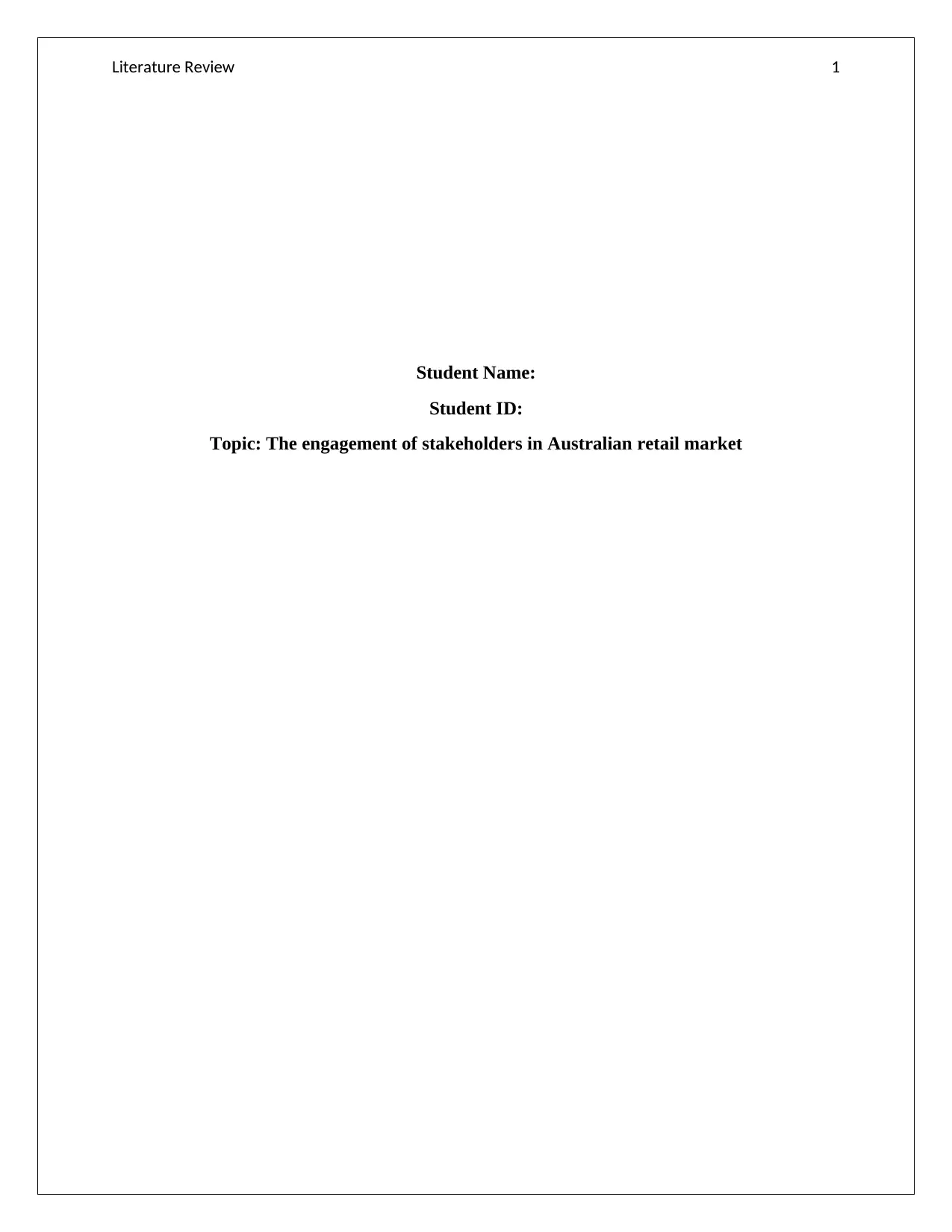
Literature Review 1
Student Name:
Student ID:
Topic: The engagement of stakeholders in Australian retail market
Student Name:
Student ID:
Topic: The engagement of stakeholders in Australian retail market
Paraphrase This Document
Need a fresh take? Get an instant paraphrase of this document with our AI Paraphraser
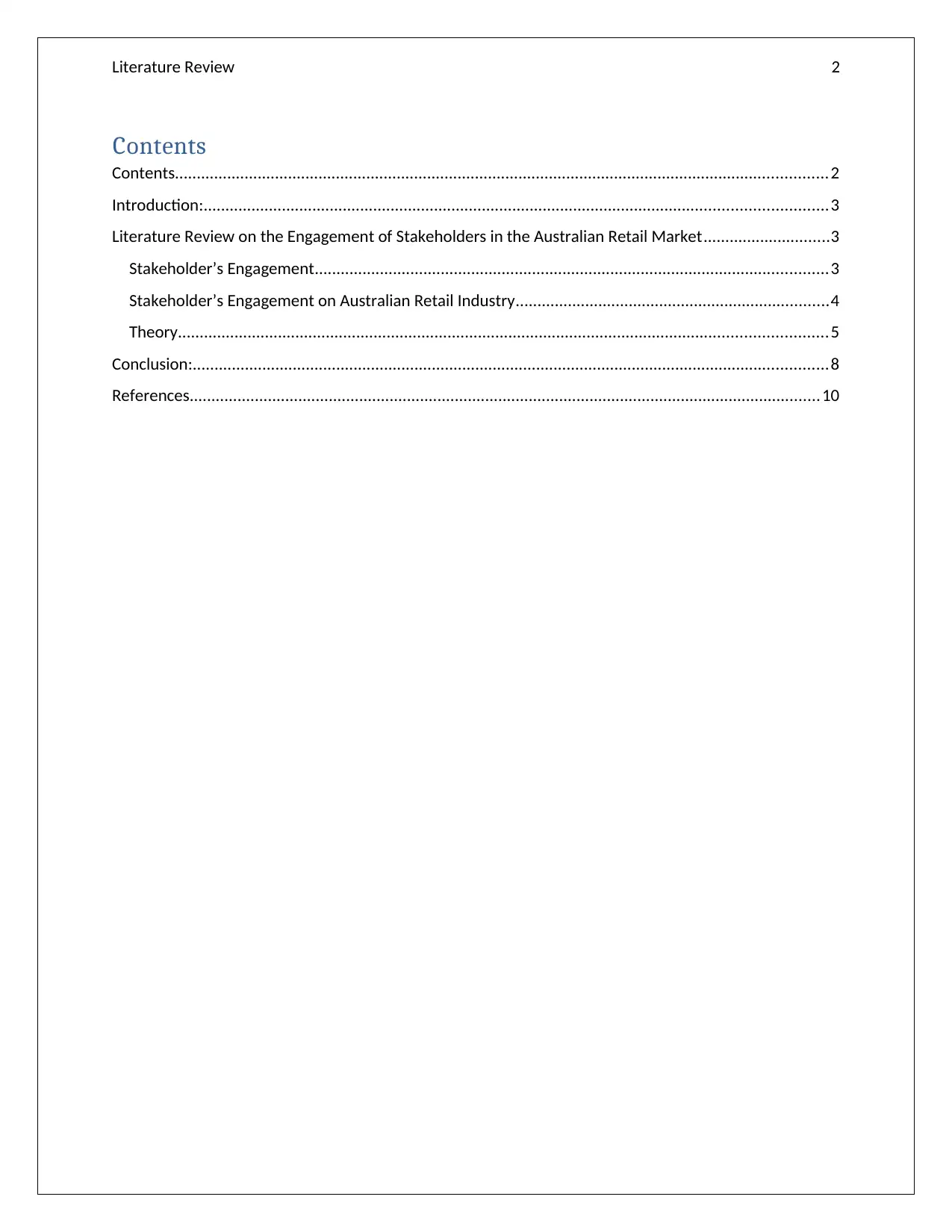
Literature Review 2
Contents
Contents......................................................................................................................................................2
Introduction:...............................................................................................................................................3
Literature Review on the Engagement of Stakeholders in the Australian Retail Market.............................3
Stakeholder’s Engagement......................................................................................................................3
Stakeholder’s Engagement on Australian Retail Industry........................................................................4
Theory.....................................................................................................................................................5
Conclusion:..................................................................................................................................................8
References.................................................................................................................................................10
Contents
Contents......................................................................................................................................................2
Introduction:...............................................................................................................................................3
Literature Review on the Engagement of Stakeholders in the Australian Retail Market.............................3
Stakeholder’s Engagement......................................................................................................................3
Stakeholder’s Engagement on Australian Retail Industry........................................................................4
Theory.....................................................................................................................................................5
Conclusion:..................................................................................................................................................8
References.................................................................................................................................................10
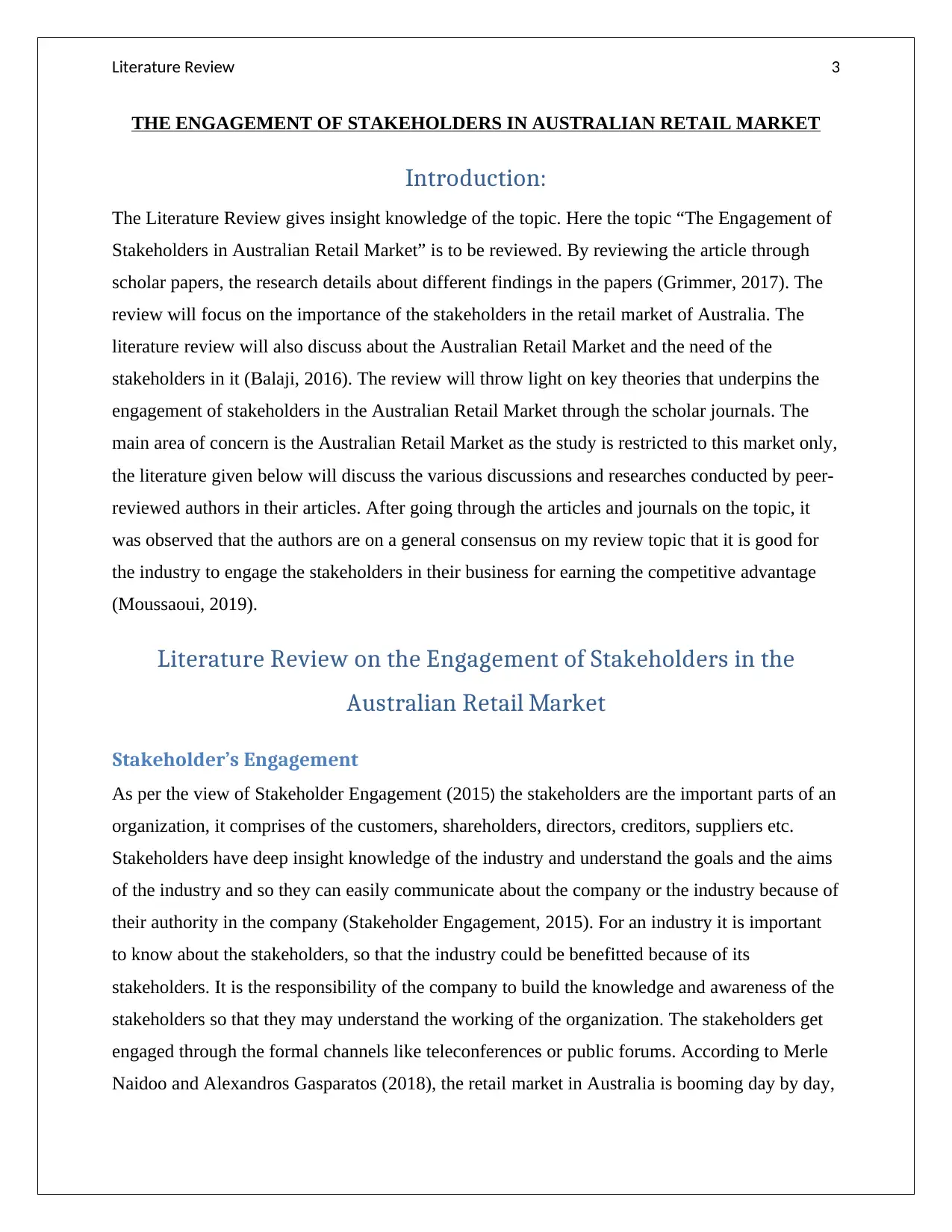
Literature Review 3
THE ENGAGEMENT OF STAKEHOLDERS IN AUSTRALIAN RETAIL MARKET
Introduction:
The Literature Review gives insight knowledge of the topic. Here the topic “The Engagement of
Stakeholders in Australian Retail Market” is to be reviewed. By reviewing the article through
scholar papers, the research details about different findings in the papers (Grimmer, 2017). The
review will focus on the importance of the stakeholders in the retail market of Australia. The
literature review will also discuss about the Australian Retail Market and the need of the
stakeholders in it (Balaji, 2016). The review will throw light on key theories that underpins the
engagement of stakeholders in the Australian Retail Market through the scholar journals. The
main area of concern is the Australian Retail Market as the study is restricted to this market only,
the literature given below will discuss the various discussions and researches conducted by peer-
reviewed authors in their articles. After going through the articles and journals on the topic, it
was observed that the authors are on a general consensus on my review topic that it is good for
the industry to engage the stakeholders in their business for earning the competitive advantage
(Moussaoui, 2019).
Literature Review on the Engagement of Stakeholders in the
Australian Retail Market
Stakeholder’s Engagement
As per the view of Stakeholder Engagement (2015) the stakeholders are the important parts of an
organization, it comprises of the customers, shareholders, directors, creditors, suppliers etc.
Stakeholders have deep insight knowledge of the industry and understand the goals and the aims
of the industry and so they can easily communicate about the company or the industry because of
their authority in the company (Stakeholder Engagement, 2015). For an industry it is important
to know about the stakeholders, so that the industry could be benefitted because of its
stakeholders. It is the responsibility of the company to build the knowledge and awareness of the
stakeholders so that they may understand the working of the organization. The stakeholders get
engaged through the formal channels like teleconferences or public forums. According to Merle
Naidoo and Alexandros Gasparatos (2018), the retail market in Australia is booming day by day,
THE ENGAGEMENT OF STAKEHOLDERS IN AUSTRALIAN RETAIL MARKET
Introduction:
The Literature Review gives insight knowledge of the topic. Here the topic “The Engagement of
Stakeholders in Australian Retail Market” is to be reviewed. By reviewing the article through
scholar papers, the research details about different findings in the papers (Grimmer, 2017). The
review will focus on the importance of the stakeholders in the retail market of Australia. The
literature review will also discuss about the Australian Retail Market and the need of the
stakeholders in it (Balaji, 2016). The review will throw light on key theories that underpins the
engagement of stakeholders in the Australian Retail Market through the scholar journals. The
main area of concern is the Australian Retail Market as the study is restricted to this market only,
the literature given below will discuss the various discussions and researches conducted by peer-
reviewed authors in their articles. After going through the articles and journals on the topic, it
was observed that the authors are on a general consensus on my review topic that it is good for
the industry to engage the stakeholders in their business for earning the competitive advantage
(Moussaoui, 2019).
Literature Review on the Engagement of Stakeholders in the
Australian Retail Market
Stakeholder’s Engagement
As per the view of Stakeholder Engagement (2015) the stakeholders are the important parts of an
organization, it comprises of the customers, shareholders, directors, creditors, suppliers etc.
Stakeholders have deep insight knowledge of the industry and understand the goals and the aims
of the industry and so they can easily communicate about the company or the industry because of
their authority in the company (Stakeholder Engagement, 2015). For an industry it is important
to know about the stakeholders, so that the industry could be benefitted because of its
stakeholders. It is the responsibility of the company to build the knowledge and awareness of the
stakeholders so that they may understand the working of the organization. The stakeholders get
engaged through the formal channels like teleconferences or public forums. According to Merle
Naidoo and Alexandros Gasparatos (2018), the retail market in Australia is booming day by day,
⊘ This is a preview!⊘
Do you want full access?
Subscribe today to unlock all pages.

Trusted by 1+ million students worldwide
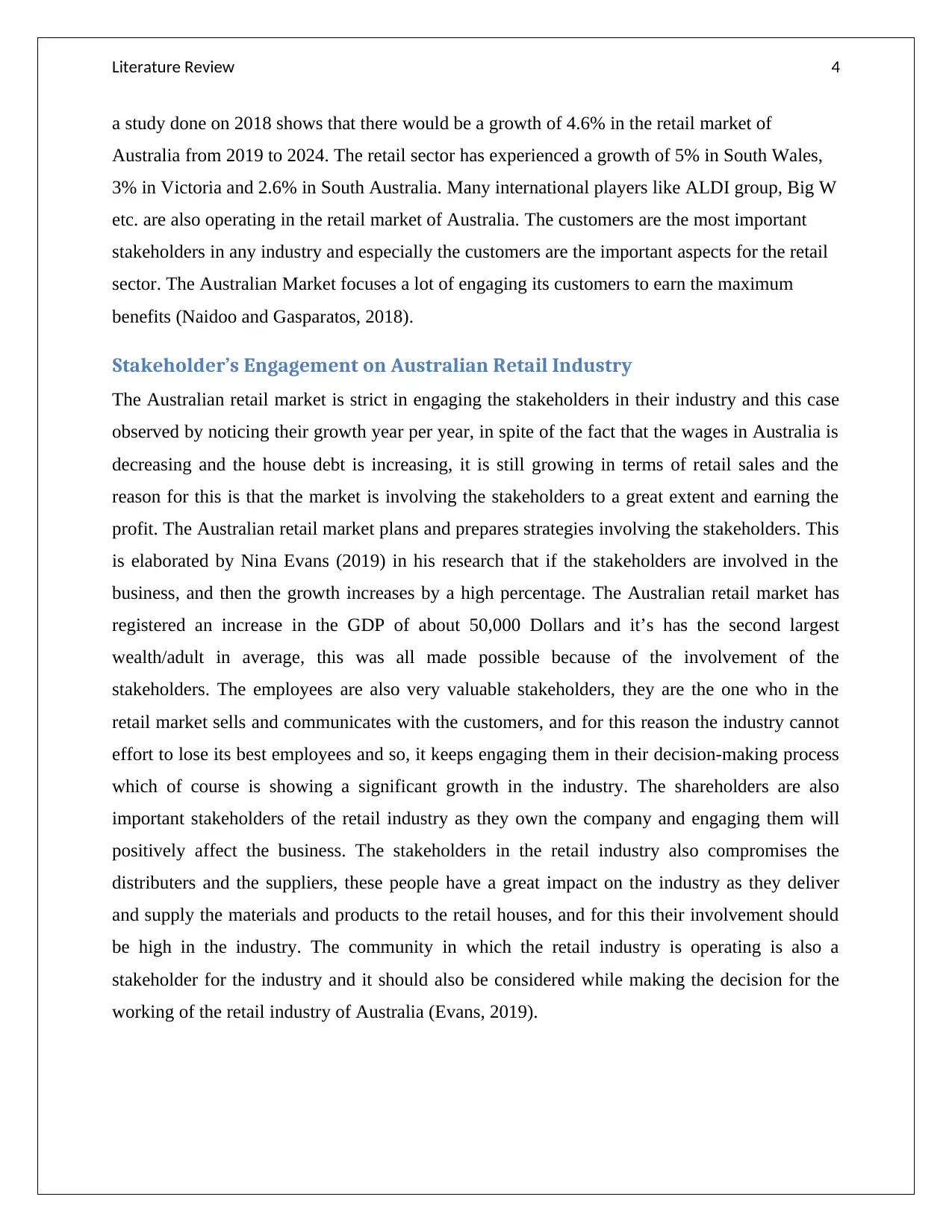
Literature Review 4
a study done on 2018 shows that there would be a growth of 4.6% in the retail market of
Australia from 2019 to 2024. The retail sector has experienced a growth of 5% in South Wales,
3% in Victoria and 2.6% in South Australia. Many international players like ALDI group, Big W
etc. are also operating in the retail market of Australia. The customers are the most important
stakeholders in any industry and especially the customers are the important aspects for the retail
sector. The Australian Market focuses a lot of engaging its customers to earn the maximum
benefits (Naidoo and Gasparatos, 2018).
Stakeholder’s Engagement on Australian Retail Industry
The Australian retail market is strict in engaging the stakeholders in their industry and this case
observed by noticing their growth year per year, in spite of the fact that the wages in Australia is
decreasing and the house debt is increasing, it is still growing in terms of retail sales and the
reason for this is that the market is involving the stakeholders to a great extent and earning the
profit. The Australian retail market plans and prepares strategies involving the stakeholders. This
is elaborated by Nina Evans (2019) in his research that if the stakeholders are involved in the
business, and then the growth increases by a high percentage. The Australian retail market has
registered an increase in the GDP of about 50,000 Dollars and it’s has the second largest
wealth/adult in average, this was all made possible because of the involvement of the
stakeholders. The employees are also very valuable stakeholders, they are the one who in the
retail market sells and communicates with the customers, and for this reason the industry cannot
effort to lose its best employees and so, it keeps engaging them in their decision-making process
which of course is showing a significant growth in the industry. The shareholders are also
important stakeholders of the retail industry as they own the company and engaging them will
positively affect the business. The stakeholders in the retail industry also compromises the
distributers and the suppliers, these people have a great impact on the industry as they deliver
and supply the materials and products to the retail houses, and for this their involvement should
be high in the industry. The community in which the retail industry is operating is also a
stakeholder for the industry and it should also be considered while making the decision for the
working of the retail industry of Australia (Evans, 2019).
a study done on 2018 shows that there would be a growth of 4.6% in the retail market of
Australia from 2019 to 2024. The retail sector has experienced a growth of 5% in South Wales,
3% in Victoria and 2.6% in South Australia. Many international players like ALDI group, Big W
etc. are also operating in the retail market of Australia. The customers are the most important
stakeholders in any industry and especially the customers are the important aspects for the retail
sector. The Australian Market focuses a lot of engaging its customers to earn the maximum
benefits (Naidoo and Gasparatos, 2018).
Stakeholder’s Engagement on Australian Retail Industry
The Australian retail market is strict in engaging the stakeholders in their industry and this case
observed by noticing their growth year per year, in spite of the fact that the wages in Australia is
decreasing and the house debt is increasing, it is still growing in terms of retail sales and the
reason for this is that the market is involving the stakeholders to a great extent and earning the
profit. The Australian retail market plans and prepares strategies involving the stakeholders. This
is elaborated by Nina Evans (2019) in his research that if the stakeholders are involved in the
business, and then the growth increases by a high percentage. The Australian retail market has
registered an increase in the GDP of about 50,000 Dollars and it’s has the second largest
wealth/adult in average, this was all made possible because of the involvement of the
stakeholders. The employees are also very valuable stakeholders, they are the one who in the
retail market sells and communicates with the customers, and for this reason the industry cannot
effort to lose its best employees and so, it keeps engaging them in their decision-making process
which of course is showing a significant growth in the industry. The shareholders are also
important stakeholders of the retail industry as they own the company and engaging them will
positively affect the business. The stakeholders in the retail industry also compromises the
distributers and the suppliers, these people have a great impact on the industry as they deliver
and supply the materials and products to the retail houses, and for this their involvement should
be high in the industry. The community in which the retail industry is operating is also a
stakeholder for the industry and it should also be considered while making the decision for the
working of the retail industry of Australia (Evans, 2019).
Paraphrase This Document
Need a fresh take? Get an instant paraphrase of this document with our AI Paraphraser
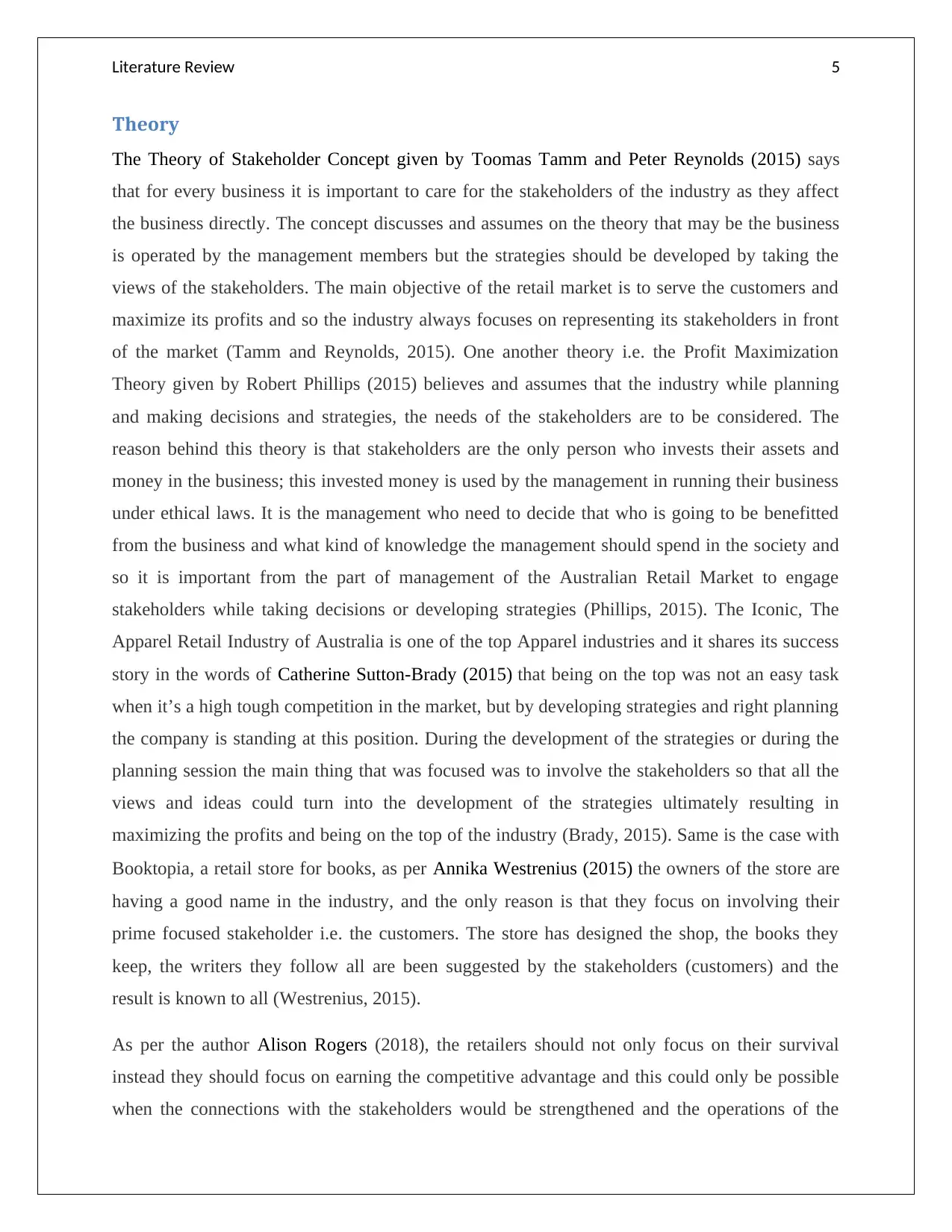
Literature Review 5
Theory
The Theory of Stakeholder Concept given by Toomas Tamm and Peter Reynolds (2015) says
that for every business it is important to care for the stakeholders of the industry as they affect
the business directly. The concept discusses and assumes on the theory that may be the business
is operated by the management members but the strategies should be developed by taking the
views of the stakeholders. The main objective of the retail market is to serve the customers and
maximize its profits and so the industry always focuses on representing its stakeholders in front
of the market (Tamm and Reynolds, 2015). One another theory i.e. the Profit Maximization
Theory given by Robert Phillips (2015) believes and assumes that the industry while planning
and making decisions and strategies, the needs of the stakeholders are to be considered. The
reason behind this theory is that stakeholders are the only person who invests their assets and
money in the business; this invested money is used by the management in running their business
under ethical laws. It is the management who need to decide that who is going to be benefitted
from the business and what kind of knowledge the management should spend in the society and
so it is important from the part of management of the Australian Retail Market to engage
stakeholders while taking decisions or developing strategies (Phillips, 2015). The Iconic, The
Apparel Retail Industry of Australia is one of the top Apparel industries and it shares its success
story in the words of Catherine Sutton-Brady (2015) that being on the top was not an easy task
when it’s a high tough competition in the market, but by developing strategies and right planning
the company is standing at this position. During the development of the strategies or during the
planning session the main thing that was focused was to involve the stakeholders so that all the
views and ideas could turn into the development of the strategies ultimately resulting in
maximizing the profits and being on the top of the industry (Brady, 2015). Same is the case with
Booktopia, a retail store for books, as per Annika Westrenius (2015) the owners of the store are
having a good name in the industry, and the only reason is that they focus on involving their
prime focused stakeholder i.e. the customers. The store has designed the shop, the books they
keep, the writers they follow all are been suggested by the stakeholders (customers) and the
result is known to all (Westrenius, 2015).
As per the author Alison Rogers (2018), the retailers should not only focus on their survival
instead they should focus on earning the competitive advantage and this could only be possible
when the connections with the stakeholders would be strengthened and the operations of the
Theory
The Theory of Stakeholder Concept given by Toomas Tamm and Peter Reynolds (2015) says
that for every business it is important to care for the stakeholders of the industry as they affect
the business directly. The concept discusses and assumes on the theory that may be the business
is operated by the management members but the strategies should be developed by taking the
views of the stakeholders. The main objective of the retail market is to serve the customers and
maximize its profits and so the industry always focuses on representing its stakeholders in front
of the market (Tamm and Reynolds, 2015). One another theory i.e. the Profit Maximization
Theory given by Robert Phillips (2015) believes and assumes that the industry while planning
and making decisions and strategies, the needs of the stakeholders are to be considered. The
reason behind this theory is that stakeholders are the only person who invests their assets and
money in the business; this invested money is used by the management in running their business
under ethical laws. It is the management who need to decide that who is going to be benefitted
from the business and what kind of knowledge the management should spend in the society and
so it is important from the part of management of the Australian Retail Market to engage
stakeholders while taking decisions or developing strategies (Phillips, 2015). The Iconic, The
Apparel Retail Industry of Australia is one of the top Apparel industries and it shares its success
story in the words of Catherine Sutton-Brady (2015) that being on the top was not an easy task
when it’s a high tough competition in the market, but by developing strategies and right planning
the company is standing at this position. During the development of the strategies or during the
planning session the main thing that was focused was to involve the stakeholders so that all the
views and ideas could turn into the development of the strategies ultimately resulting in
maximizing the profits and being on the top of the industry (Brady, 2015). Same is the case with
Booktopia, a retail store for books, as per Annika Westrenius (2015) the owners of the store are
having a good name in the industry, and the only reason is that they focus on involving their
prime focused stakeholder i.e. the customers. The store has designed the shop, the books they
keep, the writers they follow all are been suggested by the stakeholders (customers) and the
result is known to all (Westrenius, 2015).
As per the author Alison Rogers (2018), the retailers should not only focus on their survival
instead they should focus on earning the competitive advantage and this could only be possible
when the connections with the stakeholders would be strengthened and the operations of the
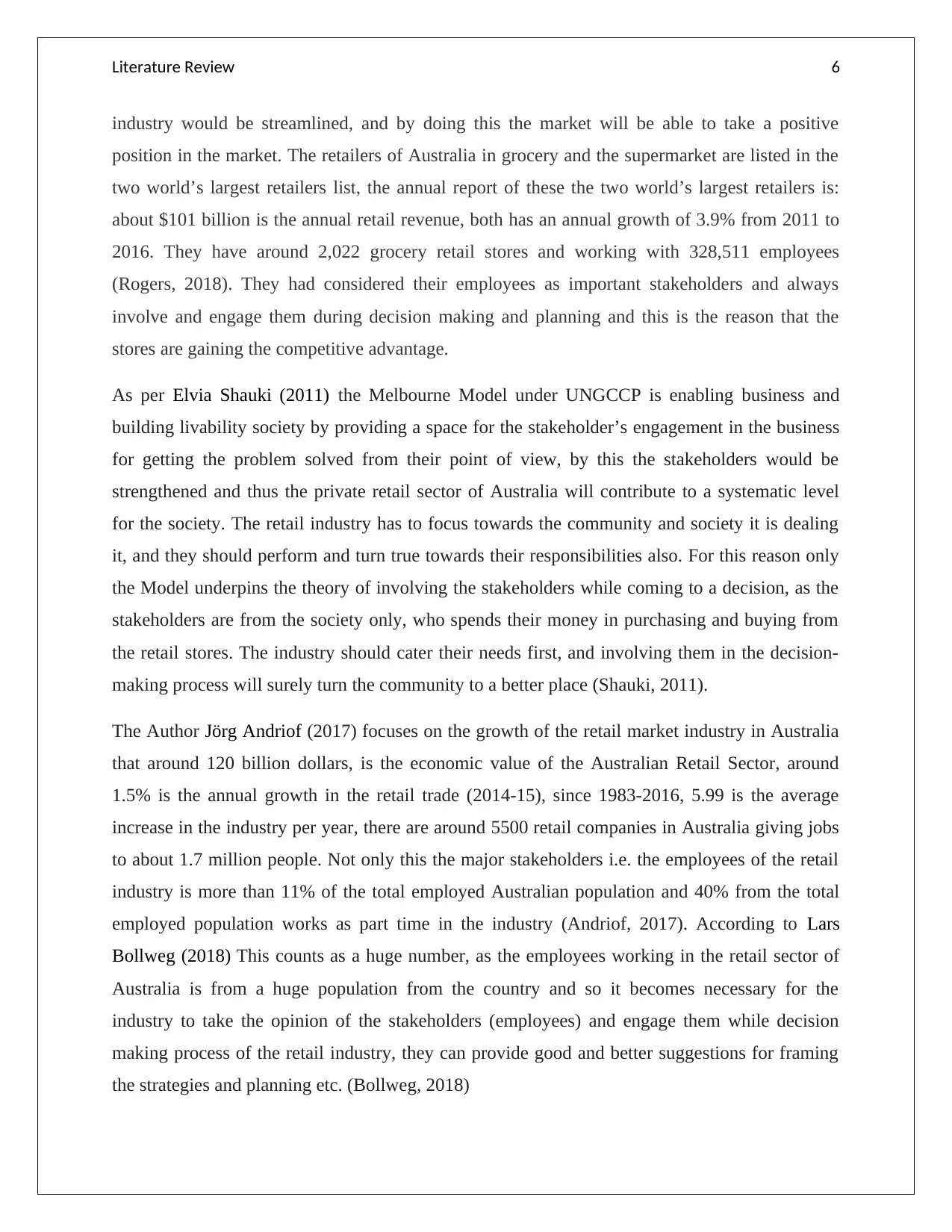
Literature Review 6
industry would be streamlined, and by doing this the market will be able to take a positive
position in the market. The retailers of Australia in grocery and the supermarket are listed in the
two world’s largest retailers list, the annual report of these the two world’s largest retailers is:
about $101 billion is the annual retail revenue, both has an annual growth of 3.9% from 2011 to
2016. They have around 2,022 grocery retail stores and working with 328,511 employees
(Rogers, 2018). They had considered their employees as important stakeholders and always
involve and engage them during decision making and planning and this is the reason that the
stores are gaining the competitive advantage.
As per Elvia Shauki (2011) the Melbourne Model under UNGCCP is enabling business and
building livability society by providing a space for the stakeholder’s engagement in the business
for getting the problem solved from their point of view, by this the stakeholders would be
strengthened and thus the private retail sector of Australia will contribute to a systematic level
for the society. The retail industry has to focus towards the community and society it is dealing
it, and they should perform and turn true towards their responsibilities also. For this reason only
the Model underpins the theory of involving the stakeholders while coming to a decision, as the
stakeholders are from the society only, who spends their money in purchasing and buying from
the retail stores. The industry should cater their needs first, and involving them in the decision-
making process will surely turn the community to a better place (Shauki, 2011).
The Author Jörg Andriof (2017) focuses on the growth of the retail market industry in Australia
that around 120 billion dollars, is the economic value of the Australian Retail Sector, around
1.5% is the annual growth in the retail trade (2014-15), since 1983-2016, 5.99 is the average
increase in the industry per year, there are around 5500 retail companies in Australia giving jobs
to about 1.7 million people. Not only this the major stakeholders i.e. the employees of the retail
industry is more than 11% of the total employed Australian population and 40% from the total
employed population works as part time in the industry (Andriof, 2017). According to Lars
Bollweg (2018) This counts as a huge number, as the employees working in the retail sector of
Australia is from a huge population from the country and so it becomes necessary for the
industry to take the opinion of the stakeholders (employees) and engage them while decision
making process of the retail industry, they can provide good and better suggestions for framing
the strategies and planning etc. (Bollweg, 2018)
industry would be streamlined, and by doing this the market will be able to take a positive
position in the market. The retailers of Australia in grocery and the supermarket are listed in the
two world’s largest retailers list, the annual report of these the two world’s largest retailers is:
about $101 billion is the annual retail revenue, both has an annual growth of 3.9% from 2011 to
2016. They have around 2,022 grocery retail stores and working with 328,511 employees
(Rogers, 2018). They had considered their employees as important stakeholders and always
involve and engage them during decision making and planning and this is the reason that the
stores are gaining the competitive advantage.
As per Elvia Shauki (2011) the Melbourne Model under UNGCCP is enabling business and
building livability society by providing a space for the stakeholder’s engagement in the business
for getting the problem solved from their point of view, by this the stakeholders would be
strengthened and thus the private retail sector of Australia will contribute to a systematic level
for the society. The retail industry has to focus towards the community and society it is dealing
it, and they should perform and turn true towards their responsibilities also. For this reason only
the Model underpins the theory of involving the stakeholders while coming to a decision, as the
stakeholders are from the society only, who spends their money in purchasing and buying from
the retail stores. The industry should cater their needs first, and involving them in the decision-
making process will surely turn the community to a better place (Shauki, 2011).
The Author Jörg Andriof (2017) focuses on the growth of the retail market industry in Australia
that around 120 billion dollars, is the economic value of the Australian Retail Sector, around
1.5% is the annual growth in the retail trade (2014-15), since 1983-2016, 5.99 is the average
increase in the industry per year, there are around 5500 retail companies in Australia giving jobs
to about 1.7 million people. Not only this the major stakeholders i.e. the employees of the retail
industry is more than 11% of the total employed Australian population and 40% from the total
employed population works as part time in the industry (Andriof, 2017). According to Lars
Bollweg (2018) This counts as a huge number, as the employees working in the retail sector of
Australia is from a huge population from the country and so it becomes necessary for the
industry to take the opinion of the stakeholders (employees) and engage them while decision
making process of the retail industry, they can provide good and better suggestions for framing
the strategies and planning etc. (Bollweg, 2018)
⊘ This is a preview!⊘
Do you want full access?
Subscribe today to unlock all pages.

Trusted by 1+ million students worldwide
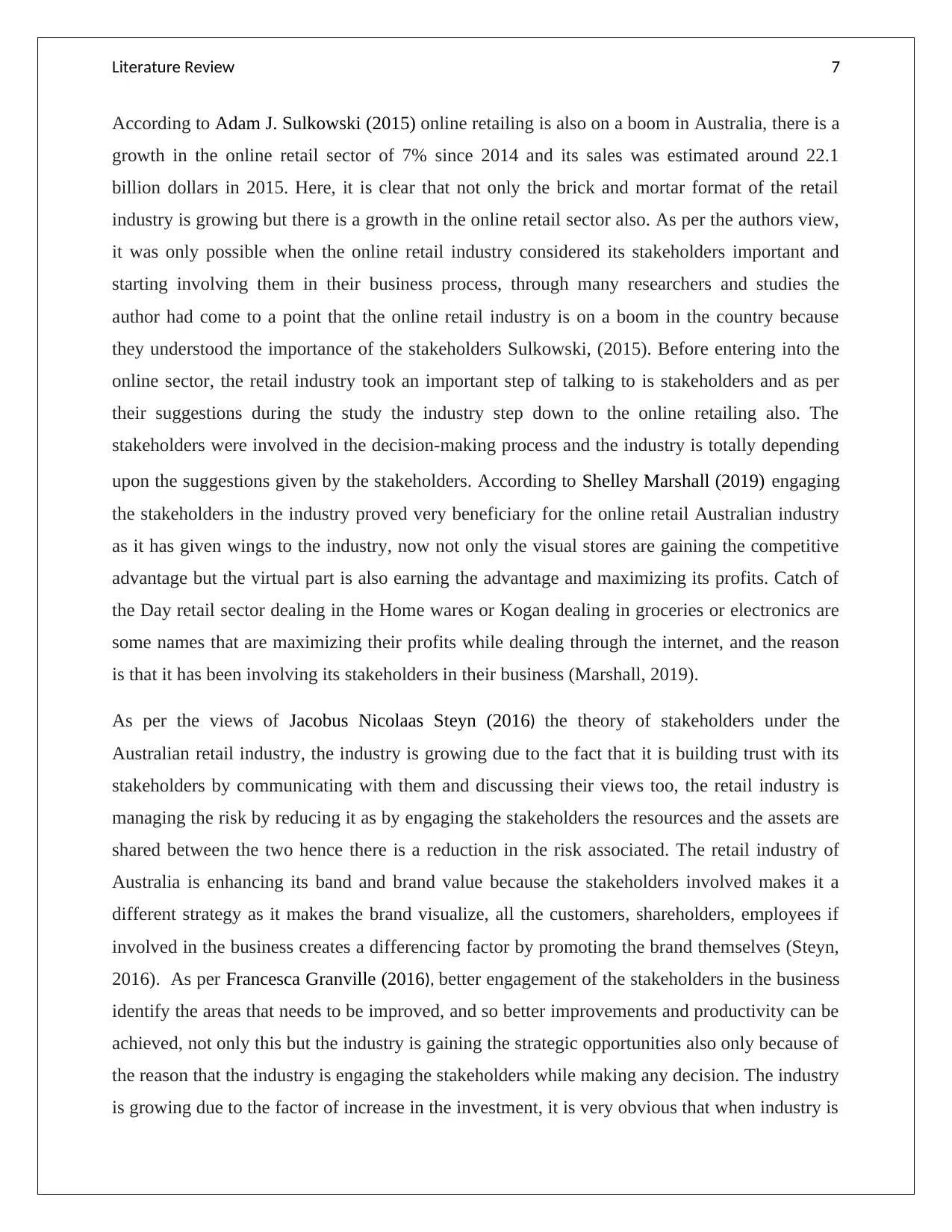
Literature Review 7
According to Adam J. Sulkowski (2015) online retailing is also on a boom in Australia, there is a
growth in the online retail sector of 7% since 2014 and its sales was estimated around 22.1
billion dollars in 2015. Here, it is clear that not only the brick and mortar format of the retail
industry is growing but there is a growth in the online retail sector also. As per the authors view,
it was only possible when the online retail industry considered its stakeholders important and
starting involving them in their business process, through many researchers and studies the
author had come to a point that the online retail industry is on a boom in the country because
they understood the importance of the stakeholders Sulkowski, (2015). Before entering into the
online sector, the retail industry took an important step of talking to is stakeholders and as per
their suggestions during the study the industry step down to the online retailing also. The
stakeholders were involved in the decision-making process and the industry is totally depending
upon the suggestions given by the stakeholders. According to Shelley Marshall (2019) engaging
the stakeholders in the industry proved very beneficiary for the online retail Australian industry
as it has given wings to the industry, now not only the visual stores are gaining the competitive
advantage but the virtual part is also earning the advantage and maximizing its profits. Catch of
the Day retail sector dealing in the Home wares or Kogan dealing in groceries or electronics are
some names that are maximizing their profits while dealing through the internet, and the reason
is that it has been involving its stakeholders in their business (Marshall, 2019).
As per the views of Jacobus Nicolaas Steyn (2016) the theory of stakeholders under the
Australian retail industry, the industry is growing due to the fact that it is building trust with its
stakeholders by communicating with them and discussing their views too, the retail industry is
managing the risk by reducing it as by engaging the stakeholders the resources and the assets are
shared between the two hence there is a reduction in the risk associated. The retail industry of
Australia is enhancing its band and brand value because the stakeholders involved makes it a
different strategy as it makes the brand visualize, all the customers, shareholders, employees if
involved in the business creates a differencing factor by promoting the brand themselves (Steyn,
2016). As per Francesca Granville (2016), better engagement of the stakeholders in the business
identify the areas that needs to be improved, and so better improvements and productivity can be
achieved, not only this but the industry is gaining the strategic opportunities also only because of
the reason that the industry is engaging the stakeholders while making any decision. The industry
is growing due to the factor of increase in the investment, it is very obvious that when industry is
According to Adam J. Sulkowski (2015) online retailing is also on a boom in Australia, there is a
growth in the online retail sector of 7% since 2014 and its sales was estimated around 22.1
billion dollars in 2015. Here, it is clear that not only the brick and mortar format of the retail
industry is growing but there is a growth in the online retail sector also. As per the authors view,
it was only possible when the online retail industry considered its stakeholders important and
starting involving them in their business process, through many researchers and studies the
author had come to a point that the online retail industry is on a boom in the country because
they understood the importance of the stakeholders Sulkowski, (2015). Before entering into the
online sector, the retail industry took an important step of talking to is stakeholders and as per
their suggestions during the study the industry step down to the online retailing also. The
stakeholders were involved in the decision-making process and the industry is totally depending
upon the suggestions given by the stakeholders. According to Shelley Marshall (2019) engaging
the stakeholders in the industry proved very beneficiary for the online retail Australian industry
as it has given wings to the industry, now not only the visual stores are gaining the competitive
advantage but the virtual part is also earning the advantage and maximizing its profits. Catch of
the Day retail sector dealing in the Home wares or Kogan dealing in groceries or electronics are
some names that are maximizing their profits while dealing through the internet, and the reason
is that it has been involving its stakeholders in their business (Marshall, 2019).
As per the views of Jacobus Nicolaas Steyn (2016) the theory of stakeholders under the
Australian retail industry, the industry is growing due to the fact that it is building trust with its
stakeholders by communicating with them and discussing their views too, the retail industry is
managing the risk by reducing it as by engaging the stakeholders the resources and the assets are
shared between the two hence there is a reduction in the risk associated. The retail industry of
Australia is enhancing its band and brand value because the stakeholders involved makes it a
different strategy as it makes the brand visualize, all the customers, shareholders, employees if
involved in the business creates a differencing factor by promoting the brand themselves (Steyn,
2016). As per Francesca Granville (2016), better engagement of the stakeholders in the business
identify the areas that needs to be improved, and so better improvements and productivity can be
achieved, not only this but the industry is gaining the strategic opportunities also only because of
the reason that the industry is engaging the stakeholders while making any decision. The industry
is growing due to the factor of increase in the investment, it is very obvious that when industry is
Paraphrase This Document
Need a fresh take? Get an instant paraphrase of this document with our AI Paraphraser
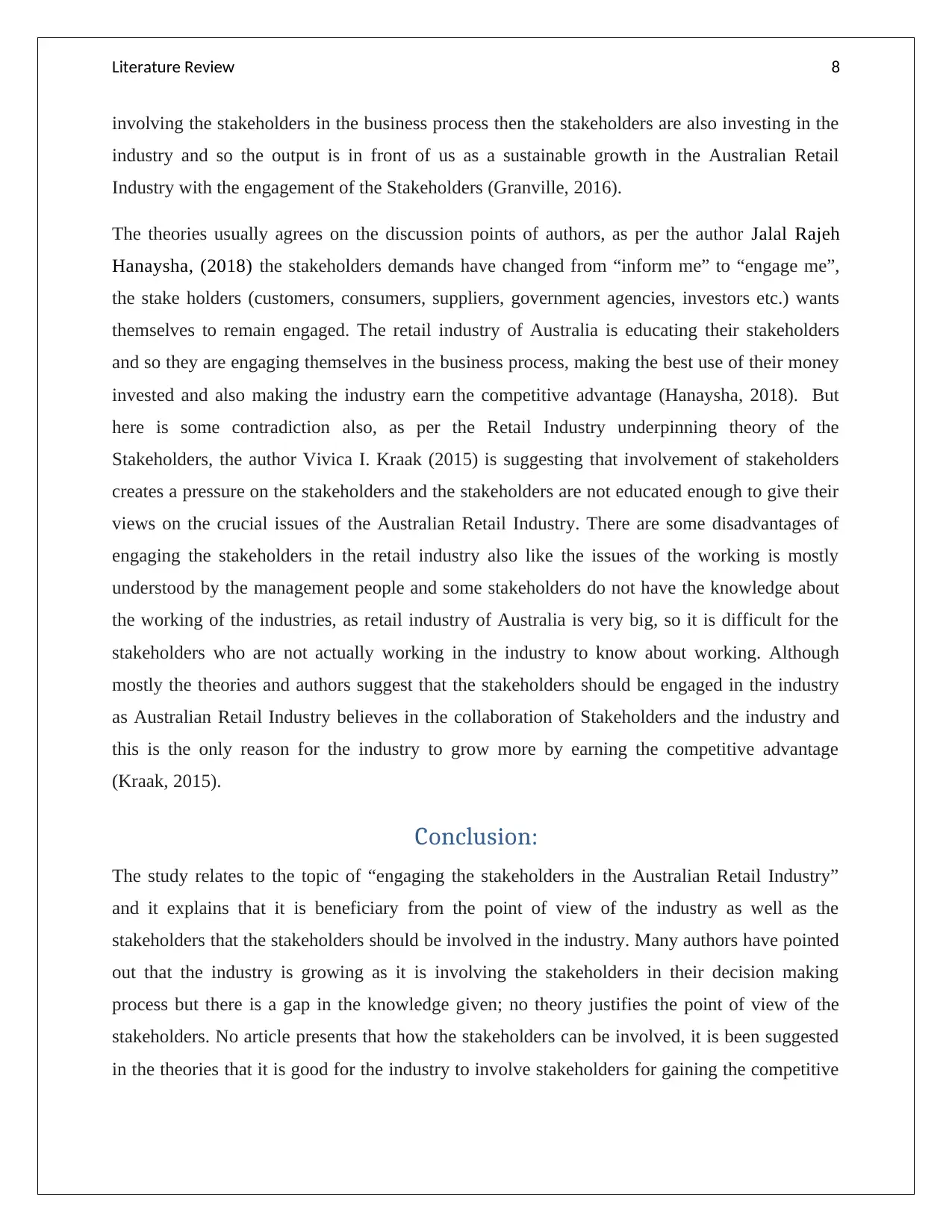
Literature Review 8
involving the stakeholders in the business process then the stakeholders are also investing in the
industry and so the output is in front of us as a sustainable growth in the Australian Retail
Industry with the engagement of the Stakeholders (Granville, 2016).
The theories usually agrees on the discussion points of authors, as per the author Jalal Rajeh
Hanaysha, (2018) the stakeholders demands have changed from “inform me” to “engage me”,
the stake holders (customers, consumers, suppliers, government agencies, investors etc.) wants
themselves to remain engaged. The retail industry of Australia is educating their stakeholders
and so they are engaging themselves in the business process, making the best use of their money
invested and also making the industry earn the competitive advantage (Hanaysha, 2018). But
here is some contradiction also, as per the Retail Industry underpinning theory of the
Stakeholders, the author Vivica I. Kraak (2015) is suggesting that involvement of stakeholders
creates a pressure on the stakeholders and the stakeholders are not educated enough to give their
views on the crucial issues of the Australian Retail Industry. There are some disadvantages of
engaging the stakeholders in the retail industry also like the issues of the working is mostly
understood by the management people and some stakeholders do not have the knowledge about
the working of the industries, as retail industry of Australia is very big, so it is difficult for the
stakeholders who are not actually working in the industry to know about working. Although
mostly the theories and authors suggest that the stakeholders should be engaged in the industry
as Australian Retail Industry believes in the collaboration of Stakeholders and the industry and
this is the only reason for the industry to grow more by earning the competitive advantage
(Kraak, 2015).
Conclusion:
The study relates to the topic of “engaging the stakeholders in the Australian Retail Industry”
and it explains that it is beneficiary from the point of view of the industry as well as the
stakeholders that the stakeholders should be involved in the industry. Many authors have pointed
out that the industry is growing as it is involving the stakeholders in their decision making
process but there is a gap in the knowledge given; no theory justifies the point of view of the
stakeholders. No article presents that how the stakeholders can be involved, it is been suggested
in the theories that it is good for the industry to involve stakeholders for gaining the competitive
involving the stakeholders in the business process then the stakeholders are also investing in the
industry and so the output is in front of us as a sustainable growth in the Australian Retail
Industry with the engagement of the Stakeholders (Granville, 2016).
The theories usually agrees on the discussion points of authors, as per the author Jalal Rajeh
Hanaysha, (2018) the stakeholders demands have changed from “inform me” to “engage me”,
the stake holders (customers, consumers, suppliers, government agencies, investors etc.) wants
themselves to remain engaged. The retail industry of Australia is educating their stakeholders
and so they are engaging themselves in the business process, making the best use of their money
invested and also making the industry earn the competitive advantage (Hanaysha, 2018). But
here is some contradiction also, as per the Retail Industry underpinning theory of the
Stakeholders, the author Vivica I. Kraak (2015) is suggesting that involvement of stakeholders
creates a pressure on the stakeholders and the stakeholders are not educated enough to give their
views on the crucial issues of the Australian Retail Industry. There are some disadvantages of
engaging the stakeholders in the retail industry also like the issues of the working is mostly
understood by the management people and some stakeholders do not have the knowledge about
the working of the industries, as retail industry of Australia is very big, so it is difficult for the
stakeholders who are not actually working in the industry to know about working. Although
mostly the theories and authors suggest that the stakeholders should be engaged in the industry
as Australian Retail Industry believes in the collaboration of Stakeholders and the industry and
this is the only reason for the industry to grow more by earning the competitive advantage
(Kraak, 2015).
Conclusion:
The study relates to the topic of “engaging the stakeholders in the Australian Retail Industry”
and it explains that it is beneficiary from the point of view of the industry as well as the
stakeholders that the stakeholders should be involved in the industry. Many authors have pointed
out that the industry is growing as it is involving the stakeholders in their decision making
process but there is a gap in the knowledge given; no theory justifies the point of view of the
stakeholders. No article presents that how the stakeholders can be involved, it is been suggested
in the theories that it is good for the industry to involve stakeholders for gaining the competitive
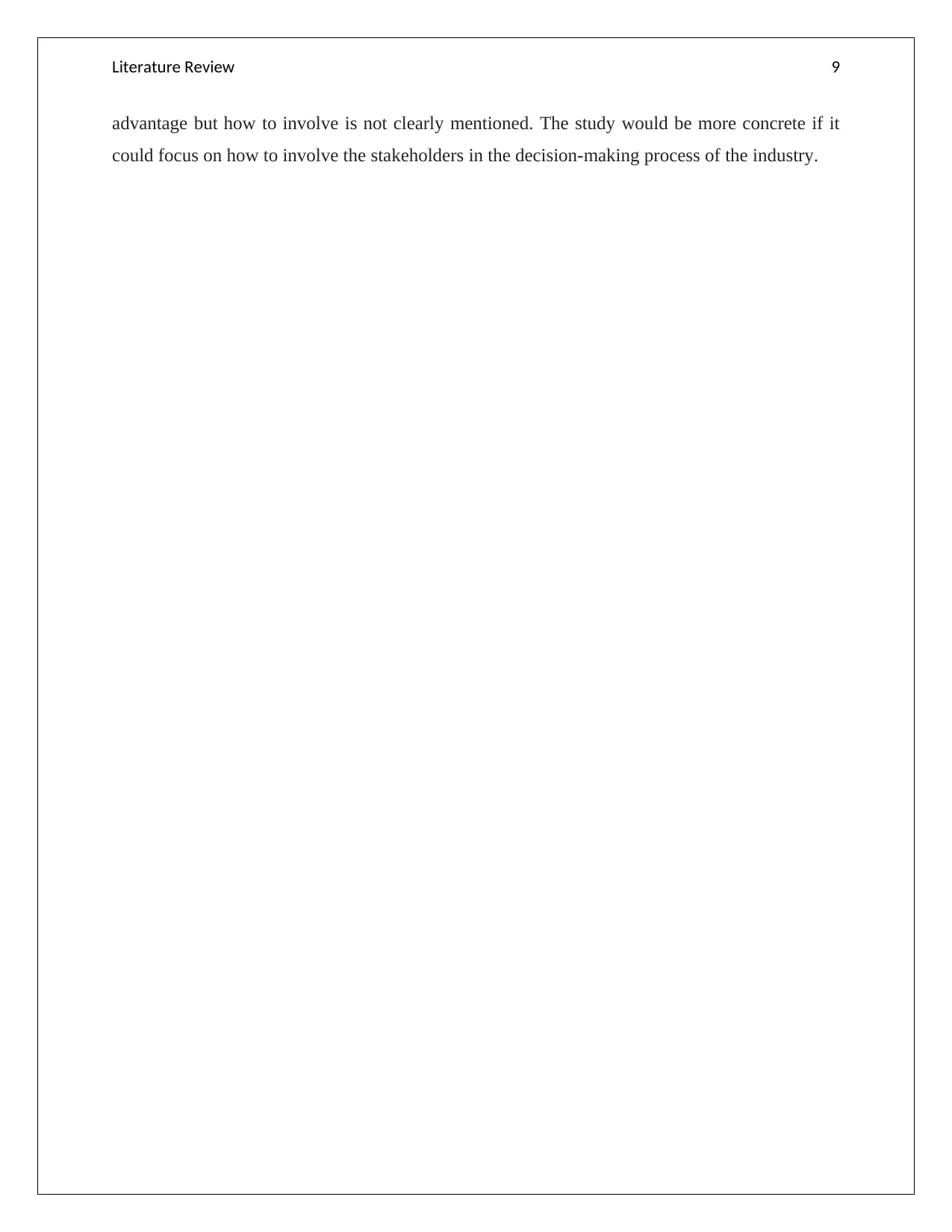
Literature Review 9
advantage but how to involve is not clearly mentioned. The study would be more concrete if it
could focus on how to involve the stakeholders in the decision-making process of the industry.
advantage but how to involve is not clearly mentioned. The study would be more concrete if it
could focus on how to involve the stakeholders in the decision-making process of the industry.
⊘ This is a preview!⊘
Do you want full access?
Subscribe today to unlock all pages.

Trusted by 1+ million students worldwide
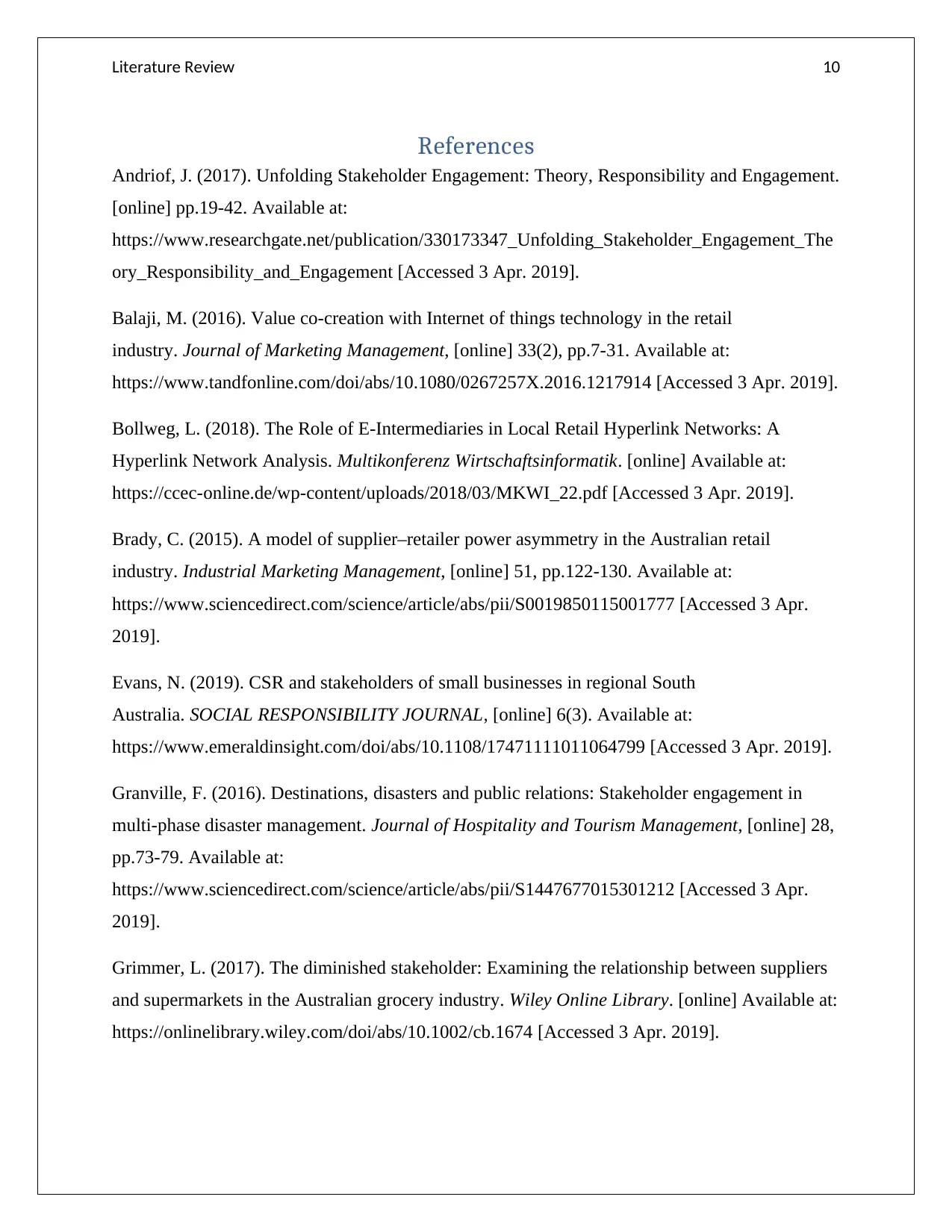
Literature Review 10
References
Andriof, J. (2017). Unfolding Stakeholder Engagement: Theory, Responsibility and Engagement.
[online] pp.19-42. Available at:
https://www.researchgate.net/publication/330173347_Unfolding_Stakeholder_Engagement_The
ory_Responsibility_and_Engagement [Accessed 3 Apr. 2019].
Balaji, M. (2016). Value co-creation with Internet of things technology in the retail
industry. Journal of Marketing Management, [online] 33(2), pp.7-31. Available at:
https://www.tandfonline.com/doi/abs/10.1080/0267257X.2016.1217914 [Accessed 3 Apr. 2019].
Bollweg, L. (2018). The Role of E-Intermediaries in Local Retail Hyperlink Networks: A
Hyperlink Network Analysis. Multikonferenz Wirtschaftsinformatik. [online] Available at:
https://ccec-online.de/wp-content/uploads/2018/03/MKWI_22.pdf [Accessed 3 Apr. 2019].
Brady, C. (2015). A model of supplier–retailer power asymmetry in the Australian retail
industry. Industrial Marketing Management, [online] 51, pp.122-130. Available at:
https://www.sciencedirect.com/science/article/abs/pii/S0019850115001777 [Accessed 3 Apr.
2019].
Evans, N. (2019). CSR and stakeholders of small businesses in regional South
Australia. SOCIAL RESPONSIBILITY JOURNAL, [online] 6(3). Available at:
https://www.emeraldinsight.com/doi/abs/10.1108/17471111011064799 [Accessed 3 Apr. 2019].
Granville, F. (2016). Destinations, disasters and public relations: Stakeholder engagement in
multi-phase disaster management. Journal of Hospitality and Tourism Management, [online] 28,
pp.73-79. Available at:
https://www.sciencedirect.com/science/article/abs/pii/S1447677015301212 [Accessed 3 Apr.
2019].
Grimmer, L. (2017). The diminished stakeholder: Examining the relationship between suppliers
and supermarkets in the Australian grocery industry. Wiley Online Library. [online] Available at:
https://onlinelibrary.wiley.com/doi/abs/10.1002/cb.1674 [Accessed 3 Apr. 2019].
References
Andriof, J. (2017). Unfolding Stakeholder Engagement: Theory, Responsibility and Engagement.
[online] pp.19-42. Available at:
https://www.researchgate.net/publication/330173347_Unfolding_Stakeholder_Engagement_The
ory_Responsibility_and_Engagement [Accessed 3 Apr. 2019].
Balaji, M. (2016). Value co-creation with Internet of things technology in the retail
industry. Journal of Marketing Management, [online] 33(2), pp.7-31. Available at:
https://www.tandfonline.com/doi/abs/10.1080/0267257X.2016.1217914 [Accessed 3 Apr. 2019].
Bollweg, L. (2018). The Role of E-Intermediaries in Local Retail Hyperlink Networks: A
Hyperlink Network Analysis. Multikonferenz Wirtschaftsinformatik. [online] Available at:
https://ccec-online.de/wp-content/uploads/2018/03/MKWI_22.pdf [Accessed 3 Apr. 2019].
Brady, C. (2015). A model of supplier–retailer power asymmetry in the Australian retail
industry. Industrial Marketing Management, [online] 51, pp.122-130. Available at:
https://www.sciencedirect.com/science/article/abs/pii/S0019850115001777 [Accessed 3 Apr.
2019].
Evans, N. (2019). CSR and stakeholders of small businesses in regional South
Australia. SOCIAL RESPONSIBILITY JOURNAL, [online] 6(3). Available at:
https://www.emeraldinsight.com/doi/abs/10.1108/17471111011064799 [Accessed 3 Apr. 2019].
Granville, F. (2016). Destinations, disasters and public relations: Stakeholder engagement in
multi-phase disaster management. Journal of Hospitality and Tourism Management, [online] 28,
pp.73-79. Available at:
https://www.sciencedirect.com/science/article/abs/pii/S1447677015301212 [Accessed 3 Apr.
2019].
Grimmer, L. (2017). The diminished stakeholder: Examining the relationship between suppliers
and supermarkets in the Australian grocery industry. Wiley Online Library. [online] Available at:
https://onlinelibrary.wiley.com/doi/abs/10.1002/cb.1674 [Accessed 3 Apr. 2019].
Paraphrase This Document
Need a fresh take? Get an instant paraphrase of this document with our AI Paraphraser
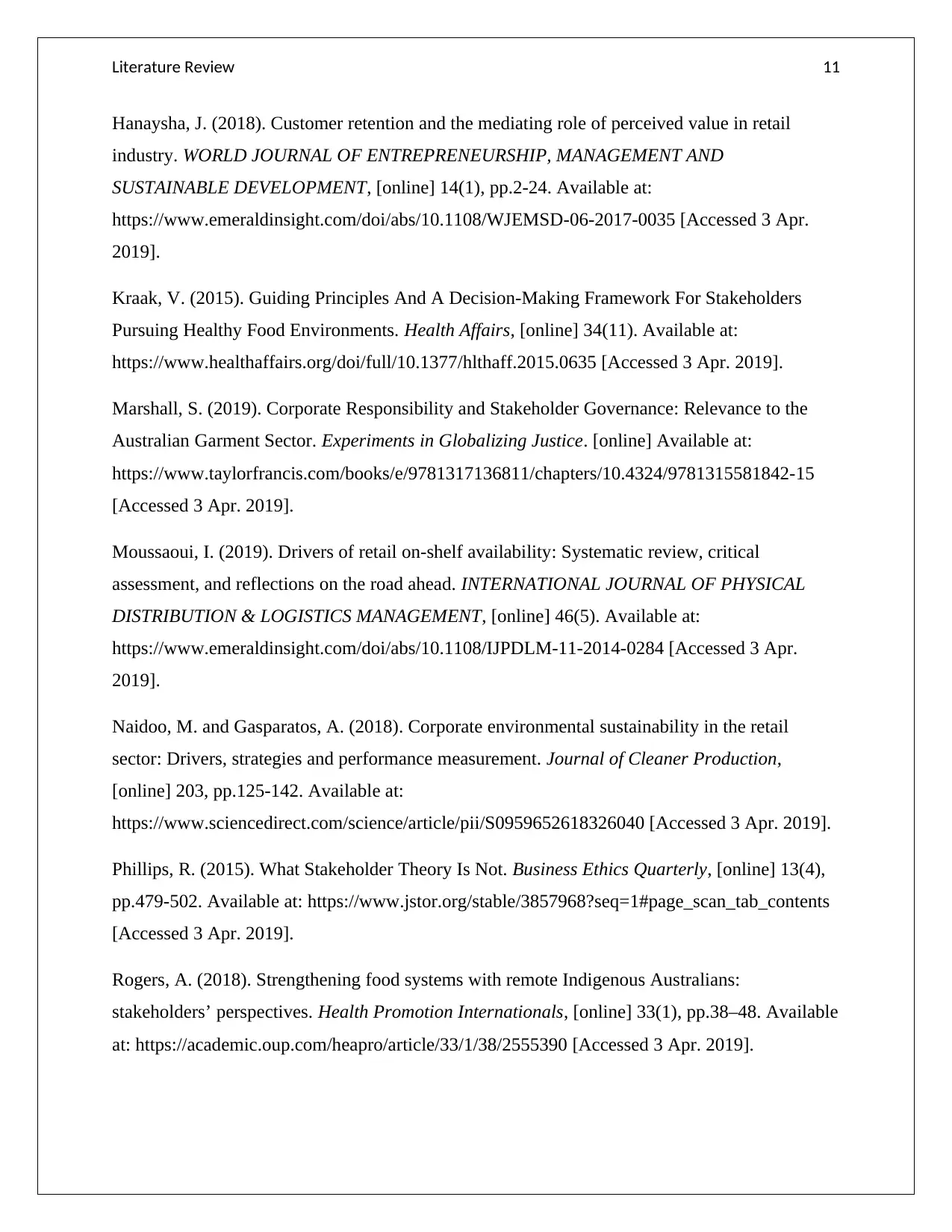
Literature Review 11
Hanaysha, J. (2018). Customer retention and the mediating role of perceived value in retail
industry. WORLD JOURNAL OF ENTREPRENEURSHIP, MANAGEMENT AND
SUSTAINABLE DEVELOPMENT, [online] 14(1), pp.2-24. Available at:
https://www.emeraldinsight.com/doi/abs/10.1108/WJEMSD-06-2017-0035 [Accessed 3 Apr.
2019].
Kraak, V. (2015). Guiding Principles And A Decision-Making Framework For Stakeholders
Pursuing Healthy Food Environments. Health Affairs, [online] 34(11). Available at:
https://www.healthaffairs.org/doi/full/10.1377/hlthaff.2015.0635 [Accessed 3 Apr. 2019].
Marshall, S. (2019). Corporate Responsibility and Stakeholder Governance: Relevance to the
Australian Garment Sector. Experiments in Globalizing Justice. [online] Available at:
https://www.taylorfrancis.com/books/e/9781317136811/chapters/10.4324/9781315581842-15
[Accessed 3 Apr. 2019].
Moussaoui, I. (2019). Drivers of retail on-shelf availability: Systematic review, critical
assessment, and reflections on the road ahead. INTERNATIONAL JOURNAL OF PHYSICAL
DISTRIBUTION & LOGISTICS MANAGEMENT, [online] 46(5). Available at:
https://www.emeraldinsight.com/doi/abs/10.1108/IJPDLM-11-2014-0284 [Accessed 3 Apr.
2019].
Naidoo, M. and Gasparatos, A. (2018). Corporate environmental sustainability in the retail
sector: Drivers, strategies and performance measurement. Journal of Cleaner Production,
[online] 203, pp.125-142. Available at:
https://www.sciencedirect.com/science/article/pii/S0959652618326040 [Accessed 3 Apr. 2019].
Phillips, R. (2015). What Stakeholder Theory Is Not. Business Ethics Quarterly, [online] 13(4),
pp.479-502. Available at: https://www.jstor.org/stable/3857968?seq=1#page_scan_tab_contents
[Accessed 3 Apr. 2019].
Rogers, A. (2018). Strengthening food systems with remote Indigenous Australians:
stakeholders’ perspectives. Health Promotion Internationals, [online] 33(1), pp.38–48. Available
at: https://academic.oup.com/heapro/article/33/1/38/2555390 [Accessed 3 Apr. 2019].
Hanaysha, J. (2018). Customer retention and the mediating role of perceived value in retail
industry. WORLD JOURNAL OF ENTREPRENEURSHIP, MANAGEMENT AND
SUSTAINABLE DEVELOPMENT, [online] 14(1), pp.2-24. Available at:
https://www.emeraldinsight.com/doi/abs/10.1108/WJEMSD-06-2017-0035 [Accessed 3 Apr.
2019].
Kraak, V. (2015). Guiding Principles And A Decision-Making Framework For Stakeholders
Pursuing Healthy Food Environments. Health Affairs, [online] 34(11). Available at:
https://www.healthaffairs.org/doi/full/10.1377/hlthaff.2015.0635 [Accessed 3 Apr. 2019].
Marshall, S. (2019). Corporate Responsibility and Stakeholder Governance: Relevance to the
Australian Garment Sector. Experiments in Globalizing Justice. [online] Available at:
https://www.taylorfrancis.com/books/e/9781317136811/chapters/10.4324/9781315581842-15
[Accessed 3 Apr. 2019].
Moussaoui, I. (2019). Drivers of retail on-shelf availability: Systematic review, critical
assessment, and reflections on the road ahead. INTERNATIONAL JOURNAL OF PHYSICAL
DISTRIBUTION & LOGISTICS MANAGEMENT, [online] 46(5). Available at:
https://www.emeraldinsight.com/doi/abs/10.1108/IJPDLM-11-2014-0284 [Accessed 3 Apr.
2019].
Naidoo, M. and Gasparatos, A. (2018). Corporate environmental sustainability in the retail
sector: Drivers, strategies and performance measurement. Journal of Cleaner Production,
[online] 203, pp.125-142. Available at:
https://www.sciencedirect.com/science/article/pii/S0959652618326040 [Accessed 3 Apr. 2019].
Phillips, R. (2015). What Stakeholder Theory Is Not. Business Ethics Quarterly, [online] 13(4),
pp.479-502. Available at: https://www.jstor.org/stable/3857968?seq=1#page_scan_tab_contents
[Accessed 3 Apr. 2019].
Rogers, A. (2018). Strengthening food systems with remote Indigenous Australians:
stakeholders’ perspectives. Health Promotion Internationals, [online] 33(1), pp.38–48. Available
at: https://academic.oup.com/heapro/article/33/1/38/2555390 [Accessed 3 Apr. 2019].
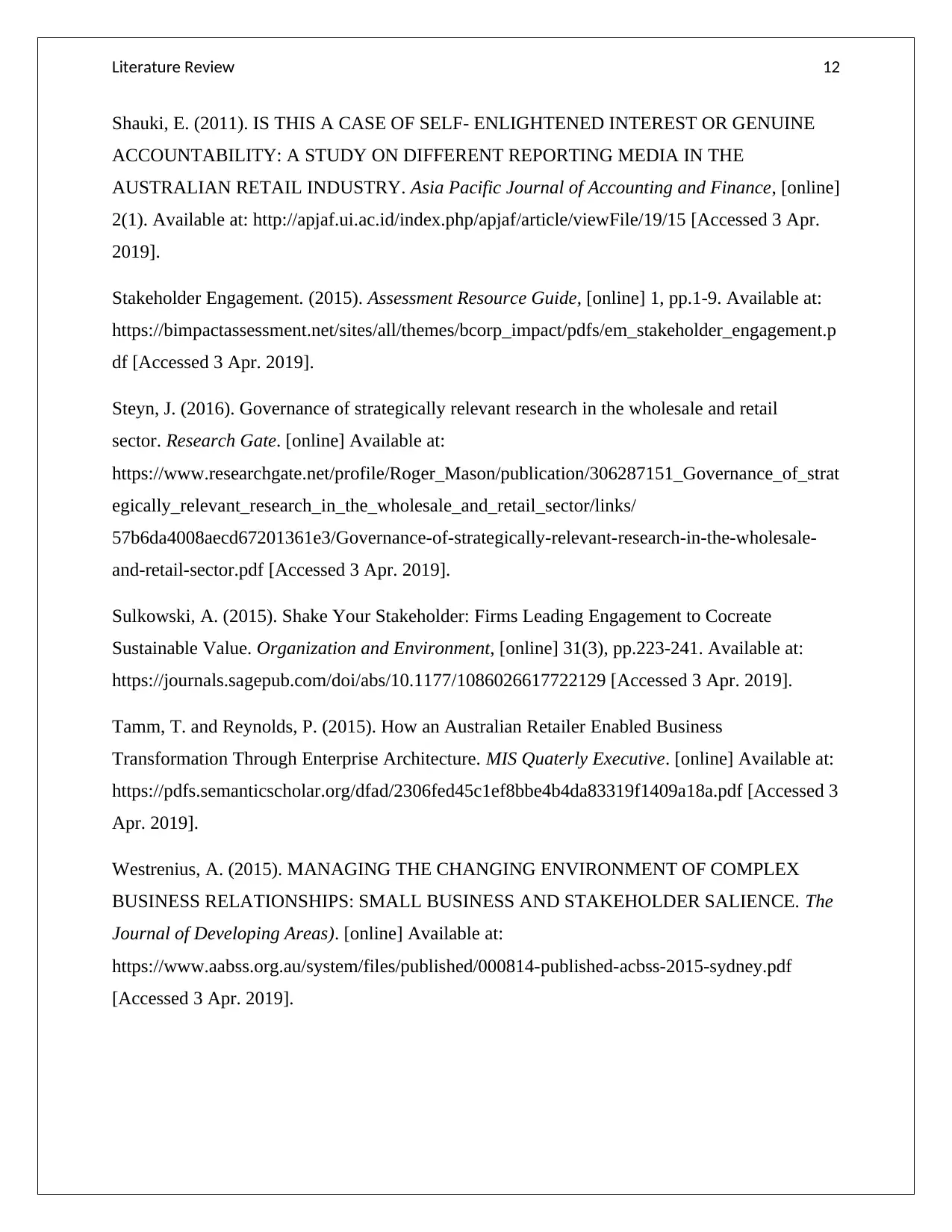
Literature Review 12
Shauki, E. (2011). IS THIS A CASE OF SELF- ENLIGHTENED INTEREST OR GENUINE
ACCOUNTABILITY: A STUDY ON DIFFERENT REPORTING MEDIA IN THE
AUSTRALIAN RETAIL INDUSTRY. Asia Pacific Journal of Accounting and Finance, [online]
2(1). Available at: http://apjaf.ui.ac.id/index.php/apjaf/article/viewFile/19/15 [Accessed 3 Apr.
2019].
Stakeholder Engagement. (2015). Assessment Resource Guide, [online] 1, pp.1-9. Available at:
https://bimpactassessment.net/sites/all/themes/bcorp_impact/pdfs/em_stakeholder_engagement.p
df [Accessed 3 Apr. 2019].
Steyn, J. (2016). Governance of strategically relevant research in the wholesale and retail
sector. Research Gate. [online] Available at:
https://www.researchgate.net/profile/Roger_Mason/publication/306287151_Governance_of_strat
egically_relevant_research_in_the_wholesale_and_retail_sector/links/
57b6da4008aecd67201361e3/Governance-of-strategically-relevant-research-in-the-wholesale-
and-retail-sector.pdf [Accessed 3 Apr. 2019].
Sulkowski, A. (2015). Shake Your Stakeholder: Firms Leading Engagement to Cocreate
Sustainable Value. Organization and Environment, [online] 31(3), pp.223-241. Available at:
https://journals.sagepub.com/doi/abs/10.1177/1086026617722129 [Accessed 3 Apr. 2019].
Tamm, T. and Reynolds, P. (2015). How an Australian Retailer Enabled Business
Transformation Through Enterprise Architecture. MIS Quaterly Executive. [online] Available at:
https://pdfs.semanticscholar.org/dfad/2306fed45c1ef8bbe4b4da83319f1409a18a.pdf [Accessed 3
Apr. 2019].
Westrenius, A. (2015). MANAGING THE CHANGING ENVIRONMENT OF COMPLEX
BUSINESS RELATIONSHIPS: SMALL BUSINESS AND STAKEHOLDER SALIENCE. The
Journal of Developing Areas). [online] Available at:
https://www.aabss.org.au/system/files/published/000814-published-acbss-2015-sydney.pdf
[Accessed 3 Apr. 2019].
Shauki, E. (2011). IS THIS A CASE OF SELF- ENLIGHTENED INTEREST OR GENUINE
ACCOUNTABILITY: A STUDY ON DIFFERENT REPORTING MEDIA IN THE
AUSTRALIAN RETAIL INDUSTRY. Asia Pacific Journal of Accounting and Finance, [online]
2(1). Available at: http://apjaf.ui.ac.id/index.php/apjaf/article/viewFile/19/15 [Accessed 3 Apr.
2019].
Stakeholder Engagement. (2015). Assessment Resource Guide, [online] 1, pp.1-9. Available at:
https://bimpactassessment.net/sites/all/themes/bcorp_impact/pdfs/em_stakeholder_engagement.p
df [Accessed 3 Apr. 2019].
Steyn, J. (2016). Governance of strategically relevant research in the wholesale and retail
sector. Research Gate. [online] Available at:
https://www.researchgate.net/profile/Roger_Mason/publication/306287151_Governance_of_strat
egically_relevant_research_in_the_wholesale_and_retail_sector/links/
57b6da4008aecd67201361e3/Governance-of-strategically-relevant-research-in-the-wholesale-
and-retail-sector.pdf [Accessed 3 Apr. 2019].
Sulkowski, A. (2015). Shake Your Stakeholder: Firms Leading Engagement to Cocreate
Sustainable Value. Organization and Environment, [online] 31(3), pp.223-241. Available at:
https://journals.sagepub.com/doi/abs/10.1177/1086026617722129 [Accessed 3 Apr. 2019].
Tamm, T. and Reynolds, P. (2015). How an Australian Retailer Enabled Business
Transformation Through Enterprise Architecture. MIS Quaterly Executive. [online] Available at:
https://pdfs.semanticscholar.org/dfad/2306fed45c1ef8bbe4b4da83319f1409a18a.pdf [Accessed 3
Apr. 2019].
Westrenius, A. (2015). MANAGING THE CHANGING ENVIRONMENT OF COMPLEX
BUSINESS RELATIONSHIPS: SMALL BUSINESS AND STAKEHOLDER SALIENCE. The
Journal of Developing Areas). [online] Available at:
https://www.aabss.org.au/system/files/published/000814-published-acbss-2015-sydney.pdf
[Accessed 3 Apr. 2019].
⊘ This is a preview!⊘
Do you want full access?
Subscribe today to unlock all pages.

Trusted by 1+ million students worldwide
1 out of 12
Related Documents
Your All-in-One AI-Powered Toolkit for Academic Success.
+13062052269
info@desklib.com
Available 24*7 on WhatsApp / Email
![[object Object]](/_next/static/media/star-bottom.7253800d.svg)
Unlock your academic potential
Copyright © 2020–2025 A2Z Services. All Rights Reserved. Developed and managed by ZUCOL.





